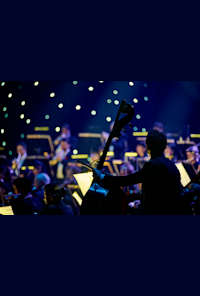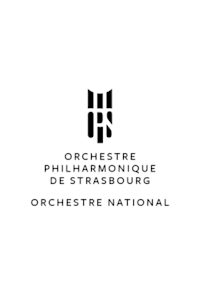Pieces
Beginnings and completion. Fourteen years old. This is the age of Felix Mendelssohn when he puts an end to the twelfth and last of his symphonies for strings. The "exercise" requested by his teacher reveals the genius that amazes Johann Wolfgang von Goethe himself. The year of his death, Felix Mendelssohn left the score of Christus unfinished . The purity and sobriety of the writing sound like a farewell. It was, on the other hand, very late that Johannes Brahms embarked on the composition of large-scale orchestral works. His Variations on a Theme by Haydn belong entirely to late Romanticism. A little-known composer, Walter Braunfels produced, in the 20thcentury, another form of completion: it pays homage to the classical cantata, to post-romantic writing and to the harmonies of its time.
Felix Mendelssohn
String Symphony No. 12 in G Minor
Between 1821 and 1823, Felix Mendelssohn composed thirteen symphonies for strings. He takes as models the symphonies of Carl Philipp Emanuel Bach and Carl Heinrich Graun. Felix Mendelssohn's teacher, Carl Friedrich Zelter requires his student to master musical writing perfectly. Friend and musical adviser to Johann Wolfgang von Goethe, former director of the Singakademie in Berlin, Zelter transmitted to him not only an extraordinary technique, but also his prodigious culture. Thanks to this authoritarian but pedagogically wise master, Felix Mendelssohn discovered the work of Bach and, in 1821, met Goethe. He was overwhelmed, as evidenced by the letter he sent to Zelter: “This little boy's gift of fantasy and his sight-reading skills are marvelous, and I would not have thought that possible in such a young child. Felix has an adult language and not the stammering of a child”.
Walter Braunfels
Das Kirchenjahr – Advent op.45
The rediscovery of the German composer took place in the early 90s. A collection of Decca records appeared under the label “Entartete Musik”. These recordings of “degenerate” music, to use the expression of Nazi propaganda, paid homage to a number of pre-war composers, most of them of Jewish origin and who had been banished from society or assassinated. This is how the opera Die Vögel (The Birds) by Walter Braunfels was engraved.
Coming from a family of musicians (his mother was the great-niece of Louis Spohr and was a friend of Clara Schumann and Franz Liszt), Walter Braunfels studied law and economics before devoting himself to composition after a meeting with conductor Felix Mottl. He took piano lessons with Theodor Leschetitzky (who taught Artur Schnabel and Ignaz Paderewski) then composition with Ludwig Thuille. An outstanding orchestrator, Walter Braunfels bequeathed to posterity a large number of orchestral scores and chamber music. The influences of Richard Strauss and Johannes Brahms are quite noticeable. However, it was in opera that he made a name for himself in the 1920s. The two works Prinzessin Brambilla and Ulenspiegel did not enjoy the success ofDie Vögel . The homage to Richard Strauss and even more to Wolfgang Amadeus Mozart seduced the book's promoters. Bruno Walter, Hans Knappertsbusch and Wilhelm Furtwängler regularly conducted the works of this composer who was, in his time, as appreciated as Richard Strauss and Franz Schreker.
In the early 1920s and faced with the rise of Nazism, Walter Braunfels converted to Catholicism. For the anecdote, Adolf Hitler, just released from prison after the failed coup d'etat in Munich, asked Walter Braunfels - a musician whom he had certainly forgotten that he was Jewish - to compose a hymn dedicated to brownshirts... In 1933, Walter Braunfels was dismissed from his post as director of the Musikhochschule in Cologne. From this period, he retired from musical life and devoted himself solely to composition. Several religious pieces were born, including a Te Deum (1921), a High Mass (1926) as well as several cantatas. They are based on the liturgical year - Das Kirchenjahr– whether it is Advent (the cantata we are hearing tonight), Christmas, Passion or Easter.
The Advent Cantata opens majestically. The organ and brass support a writing that draws its harmony from the memory of Richard Wagner and Gustav Mahler. The sound paste of the Viennese – we think here of his second and eighth symphonies – deeply marked the musical thought of Walter Braunfels, in the dialogues between the voice of the baritone soloist and the choir. The orchestration is worthy of a symphonic poem, of the great frescoes of an Arthur Honegger, in France. The work ends in apotheosis.
Johannes Brahms
Variations for orchestra on a theme by Haydn op.56a
Throughout his life, Johannes Brahms was passionate about the art of variation: homage to Johann Sebastian Bach, to Mozartian classicism, to the exploration of a new keyboard, like Ludwig van Beethoven who discovered more and more powerful fortepianos, but also on the imagination of Robert Schumann or Franz Liszt... The references are numerous, but above all they reveal the desire to master a form rich in promise, even if it means calling on more distant, drawn in particular from the Baroque universe. The form of the variation therefore occupies a considerable place in the work of Johannes Brahms and, above all, in his piano repertoire ( Variations on a theme by Schumann , on a theme by Handel, on a theme by Paganini ).
After the two serenades for strings (1858 and 1859), these famous variations appear as a new important score. Johannes Brahms came up with the idea for the theme in 1870, reading a Feldpartita in B flat major for wind octets attributed to Joseph Haydn. The song of the pilgrims of Birgenland which he discovers in the second movement and which is entitled Chorale St. Antoni, seduces him immediately. He imagines eight variations followed by a Finale .
The model for these variations is unquestionably that of Ludwig van Beethoven. The use of a relatively sober theme in its melodic dimension is in itself a promise of extraordinary developments. The variations treat, in the manner of fantasy, all the aspects of a complex work on the counterpoint but also on the harmonic and rhythmic level. Some pages like the Variations n°5 , real scherzo, could be from the hand of Ludwig van Beethoven, without the so specific orchestral paste of Johannes Brahms. Moreover, he offers some keys to listening in a letter addressed, in 1869, to his friend Adolf Schuring: “In a theme with variations, it is actually almost only the bass that counts for me. This is sacred to me, it is the firm ground on which I build my stories”. It is therefore a question of variations built on an ostinato guiding a passacaglia. The listener attends the deployment of an extraordinary sound world: joyful heroism, lovingly chiseled Sicilian, finale of an imaginary symphony, sketches of a ballet...
----
Felix Mendelssohn
Christus op.97
Felix Mendelssohn's artistic thought was steeped in faith and the Bible continually inspired him.
His religious work remains dominated by motets, cantatas, psalms and oratorios, using classical forms. In a way, he transcribed into the romantic universe the spiritual and musical power that fascinated him in Johann Sebastian Bach. Deeply Christian, he lived in a family far removed from Judaism. Baptized at the age of seven, he expressed his Lutheran faith without excessive mysticism. His two most famous oratorios, powerfully orchestrated and with typical roles, Paulus, in 1836 and Elias, in 1846, broke the boundaries between opera and religious music. Christus is placed in the continuity of these frescoes.
Christus is, however, an unfinished score, composed on a libretto by Christian Karl Josias von Bunsen, writer and Prussian diplomat. The model is that of cantatas and passions – one thinks of the Saint Matthew Passion by Jean-Sébastien Bach – with alternating recitatives and vocal ensembles. The choir symbolizes the people awaiting the crucifixion of Christ. On a bass hold, a soprano introduces the first part, The Birth of Christ . The male voices ensure a fluidity of speech, supported by the strings alone. After the first recitative, all the sections of the orchestra carry a superb melodic line, alternating between the tempi andante and allegro moderato. Felix Mendelssohn handles large ensembles admirably, creating a fusion between the timbres of the voices – mainly in the high ranges – and the instrumental colors, which has the effect of giving a feeling of sonic fullness.
The second part, The Sufferings of Christ is more extensive and contrasting. The recitatives frame rhythmically tense and delicate parts ( allegro moderato, allegro molto , etc.), framed in tight counterpoint. The winds bring a strikingly tragic element to the deployment of the masses. When the drama is over, the lyricism of the Andante con moto would pass for an operatic aria. The expression of tenderness is splendid, delicately accompanied by the pizzicati of the strings. The brief, and so modest concluding chorale, deprives itself of the presence of the winds. The work appears, obviously, unfinished.




